Your expert guide answers: is Huelva worth visiting? (2024)

Let’s begin by answering the question, “is Huelva worth visiting?” with an emphatic YES.
Huelva Province is one of the least visited provinces in Andalucia, southern Spain. It is magnificently beautiful; it’s quiet, full of history, charm and fabulous nature. If you’re looking to see another side of Spain, one without the hordes of tourists, to visit pristine beaches, to eat well in friendly cities and to visit historic sites, then Huelva could well be what you’re looking for.
Highlights of Huelva
Nature: Doñana National Park | Sierra de Aracena | Vía Verdes | Costa de la Luz
History: Muelle de las Carabelas | Dolmens | Museo de Huelva | Rio Tinto | Mezquita de Almonaster
Towns: Huelva | Aracena | El Rocío | Niebla | Almonaster La Real
People: the people in Huelva are extremely friendly and welcoming
There are affiliate links in this article. If you click and make a purchase I could make a small sum at zero cost to you. Thank you!
Where is Huelva?
Huelva Province borders Sevilla Province, Portugal and the Spanish autonomous region of Extremadura.
If you’re in Seville, Cádiz, or Gibraltar then it’s well worth considering taking some time to explore this under-visited yet beautiful province.
✈️ Seville airport is the nearest airport, although Faro (in Portugal’s Algarve) is not too far away either.
🚂 Huelva train station is located near the centre of the city and there are direct trains from Sevilla (1hr30).
What to do in Huelva Province
Anyone asking the question, “is Huelva worth visiting?” wants to know what there is to do in the area so let’s take a look at some of the most interesting things to do and places to visit in Huelva.
📍Because Huelva isn’t as touristy as other areas of Andalucia (think Sevilla, Malaga, Ronda and Cádiz), there are fewer tour options available to visitors. We’re really talking leaving the traditional tourist route and renting a car for most of these incredible adventures.
Huelva Province: Nature
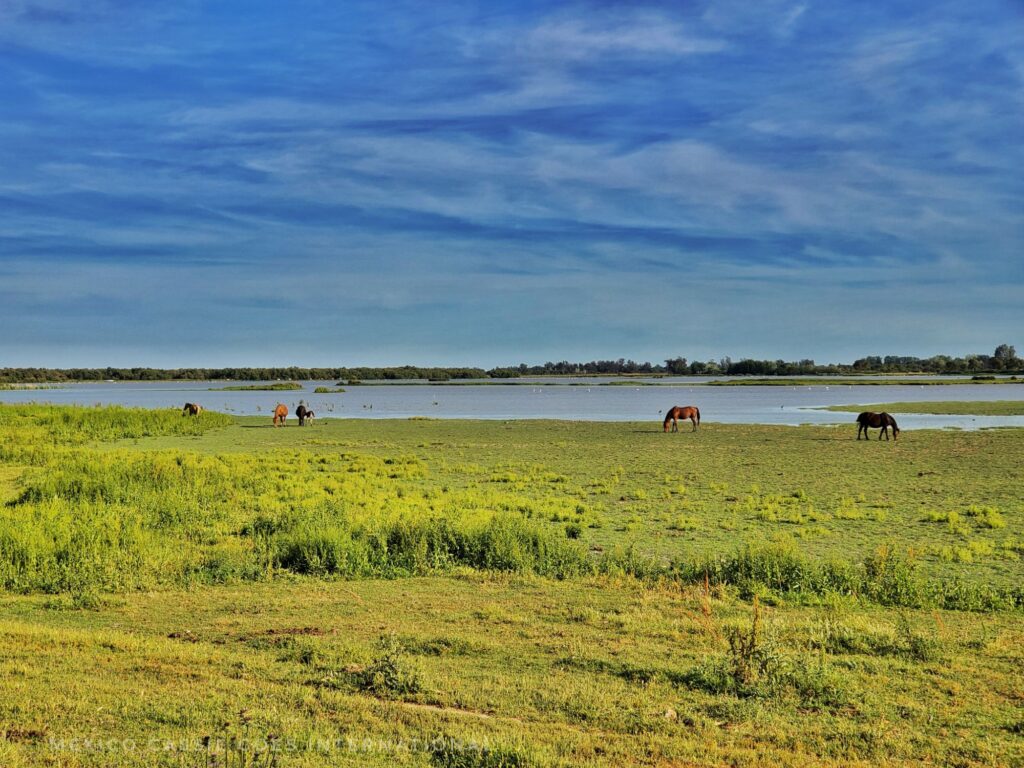
Doñana National Park
🦩 The famous Doñana national park is a UNESCO world heritage site and Europe’s most extensive wetlands. It’s also the largest roadless area in western Europe. This 601sq km park is bordered by both the Atlantic coast and by another important park, the Parque Natural de Doñana (a slightly less protected area).
This is a perfect place for nature lovers: over 360 bird species and 37 types of mammal live in the park. You may see deer, boar and if you’re lucky you might even spot an endangered lynx. Depending on the time of year, you can see flamingos, other migratory birds, and even imperial eagles (another endangered species) in the park.
Access to the park is mostly restricted to tours but there is some accessibility via the beaches around Matalascañas. There are also visitors’ centres at Acebuche, El Acebrón Palace and more.
If you love nature then Doñana National Park makes Huelva worth visiting.
⭐️ Take a 4×4 tour of Doñana National Park and El Rocio from Sevilla
Vía Verdes in Huelva
There are vía verdes across Spain. 7,600 km of old railway lines have been converted into accessible walking / biking routes for everyone. There are four to explore in Huelva Province.
➡️ Tharsis Odile, Rio Tinto, Guadiana, Molinos del Agua
Huelva’s Costa de la Luz (Coast of Light)
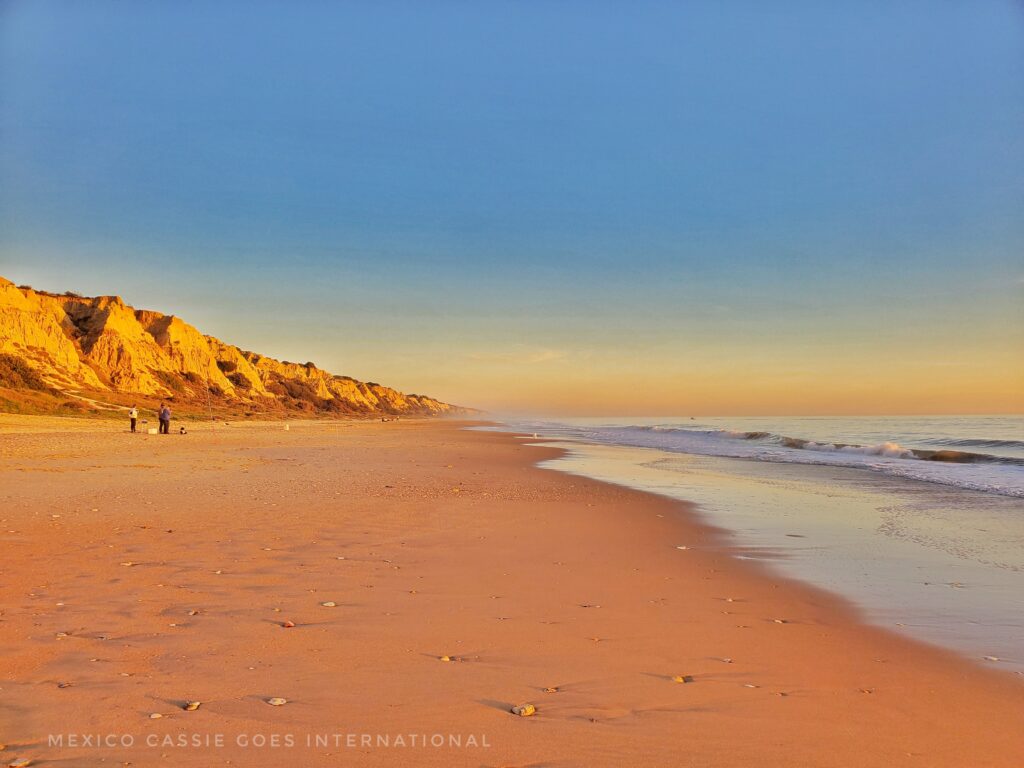
The Huelva coast forms part of the Andalucian Costa de la Luz that runs from Tarifa in Cádiz Province all the way to the mouth of the Guadiana River and the border with Portugal.
⭐️ While the Spanish have long treasured these magnificent beaches, foreigners are only recently realising the magnificent beauty of this part of the Spanish coastline.
Huelva’s beaches typically consist of wide, white sand beaches flanked by dunes and pine forests on one side and the Atlantic on the other.
Hint: These beaches are not only for the summer months but are an absolute delight all year round thanks to the mild climate of the region (just don’t plan on swimming in winter unless you’re really used to cold waters).
⭐️ The very best beach areas are around Punta Umbria, Mazagon and Matalascañas. Don’t miss Playa Rompeculos – it’s both a gorgeous beach and an incredible name (Ass Breaker Beach).
Punta Umbria
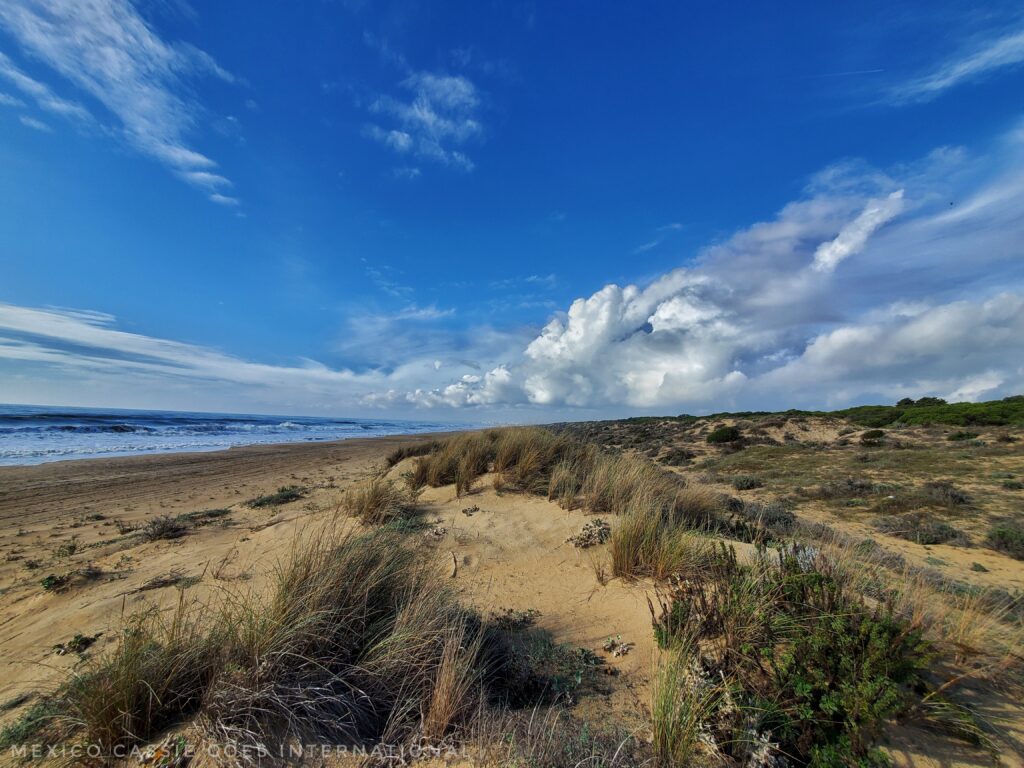
While the town of Punta Umbría and the beaches closest to town have something of a party reputation, away from town you’ll find a long sandy beach that is as wild, free and breathtaking as you might hope to find anywhere.
Matalascañas
The easiest and nearest beach to reach from Seville, this gorgeous beach is very popular with locals. However, if you have your own transport it’s easy to drive in either direction from the resort area and find nigh on deserted stretches of beach.
⭐️ My favourite spot is between Playa Matalascañas and Playa del Parador de Mazagon – around El Arenosillo and Playa Rompeculos.
Isla Cristina
Here you can find similarly wild, beautiful beaches on the Atlantic Ocean.
⭐️ Take a boat trip through the marshes from Isla Cristina
The beaches of Huelva, the wild, magnificent solitude they offer, make Huelva absolutely worth visiting.
➡️ Read more about beaches to visit from Sevilla
Huelva Province: History
Huelva’s history is extremely long, going back many thousands of years, into the earliest stages of pre-history and palaeolithic and neolithic. The Tartessians, Phoenicians, Romans, Vizigoths and Moors all left their mark on the province too.
As the early modern historical period dawned in Europe, Christopher Columbus (1451 – 1506) rose to fame. Huelva played a large part in his journey and as such, you’ll see many references to him as you explore around the city of Huelva and its environs – see below for detail.
If you’re interested in Columbus or have a fascination, like me, for pre-historic sites, Huelva is absolutely worth visiting.
What is a Dolmen?
A dolmen is a portal tomb generally dating from the late neolithic period (4000-3000 BCE). Some dolmens consist of two or more upright megaliths with a flat capstone on top. Many were covered with earth to make burial mounds.
There are thought to be around 200 neolithic burial sites in Huelva Province. The two in Huelva most likely to be on the radar for any tourists (to be honest, very few visit either) are the Dolmen de Soto and the Dolmenes de Pozuelo.
Dolmen de Soto
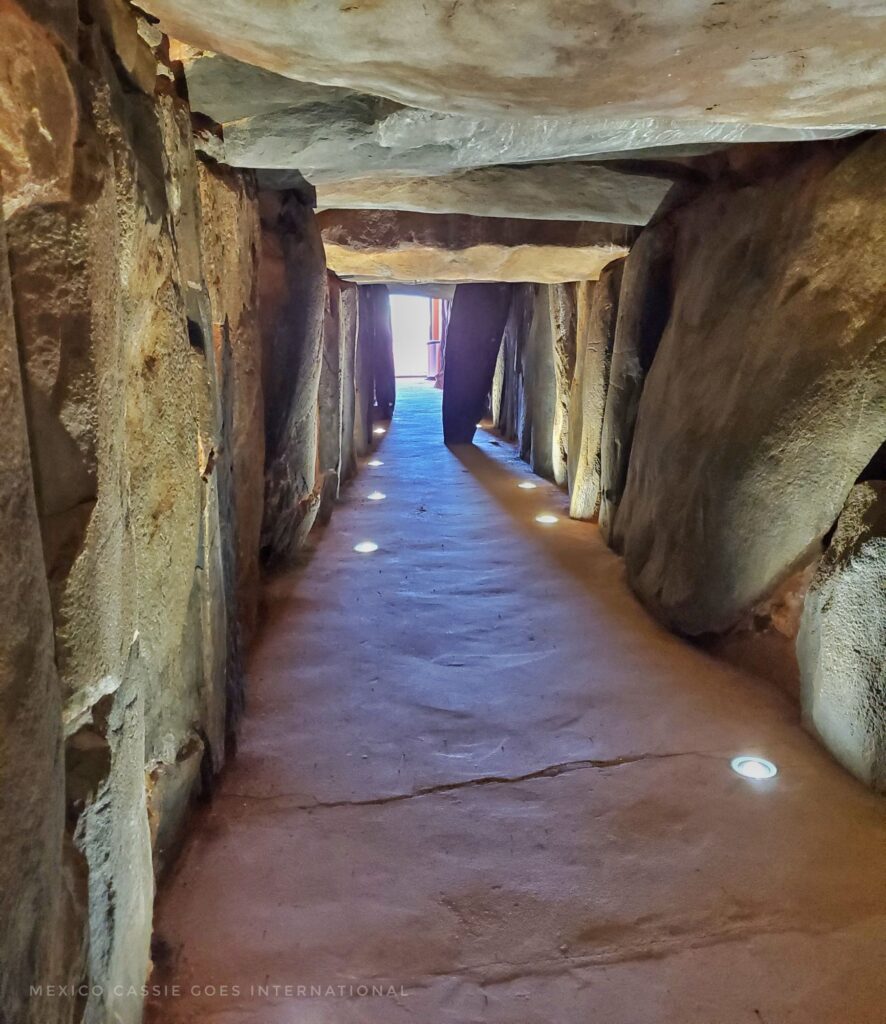
This subterranean structure located just outside the small town of Trigueros in Huelva Province is thought to be one of the largest dolmens in all of Spain and it is estimated to be between 4,500 – 5,000 years old. It was discovered only 100 years ago when the owner of the land wanted to build a new house on top of it.
The dolmen is a 75 m diameter circular mound that you can enter to examine the ancient engravings on the stones inside. You enter as part of a group with a guide (in Spanish) after watching a short explanatory video (with English subtitles).
📌 Entrance is free but you must book in advance. You will be turned away if you show up without a ticket.
⭐️ If you’re interested in dolmens, you should also visit the city of Antequera in the centre of Andalucia as there are two fabulous examples of dolmens here and the new visitors’ centre is truly excellent.
Pozuelo Site
In the centre of Huelva Province, near Zalamea la Real lies this site, home to 11 dolmens. I haven’t visited this area yet but I understand that it’s around a 10km circular walk to see them all and unless you’re really a dolmen-nut, this might be a little much.
Los Llanetes is a sub-group of dolmens within this site that consists of four structures. Nearby is a hill that was probably a fortified settlement and there are ancient mines nearby too.
Huelva Province: Towns
Huelva City
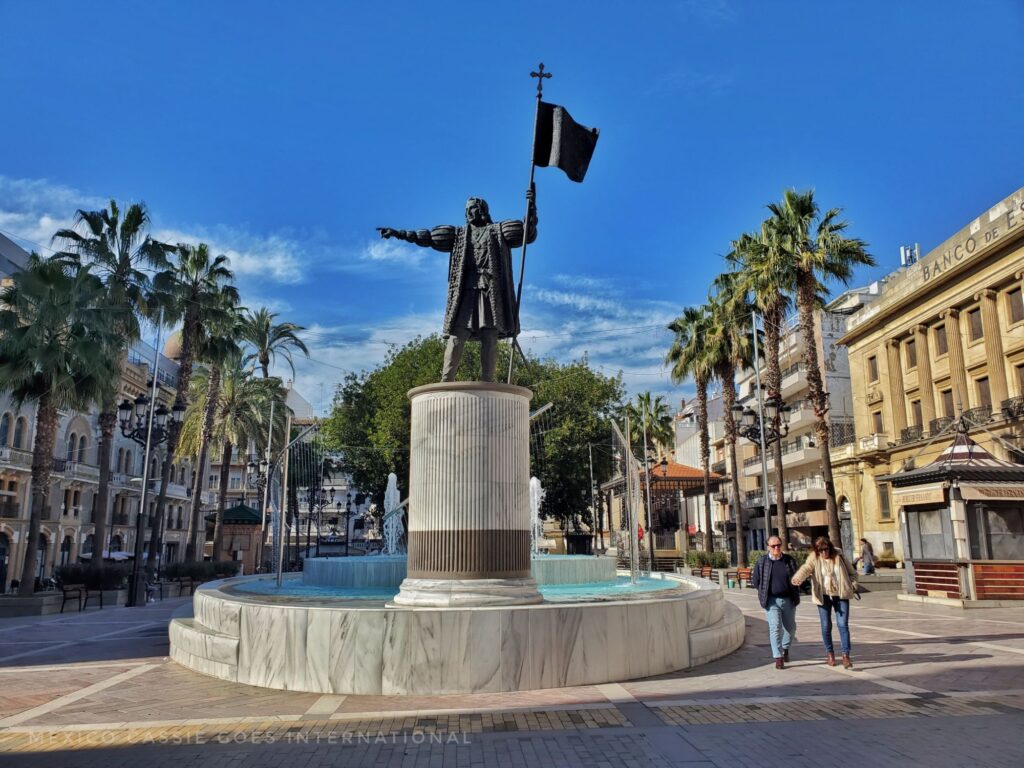
Walking around the city of Huelva you’d be forgiven for assuming it isn’t as old as many other nearby cities such as Sevilla, Cádiz and Tarifa but actually, this city is at least as old as Cádiz and was known by the Phonecians as Onuba. The reason it doesn’t look as old is that much of the city and its monuments were destroyed in the 1755 Lisbon earthquake.
Top things to do in Huelva City
Very few international travellers make it to Huelva city so there are relatively few ‘big’ things to do there but it really does make for a great day trip from Sevilla if you have a spare day. It would also fit well into a road trip around the region.
Museo de Huelva
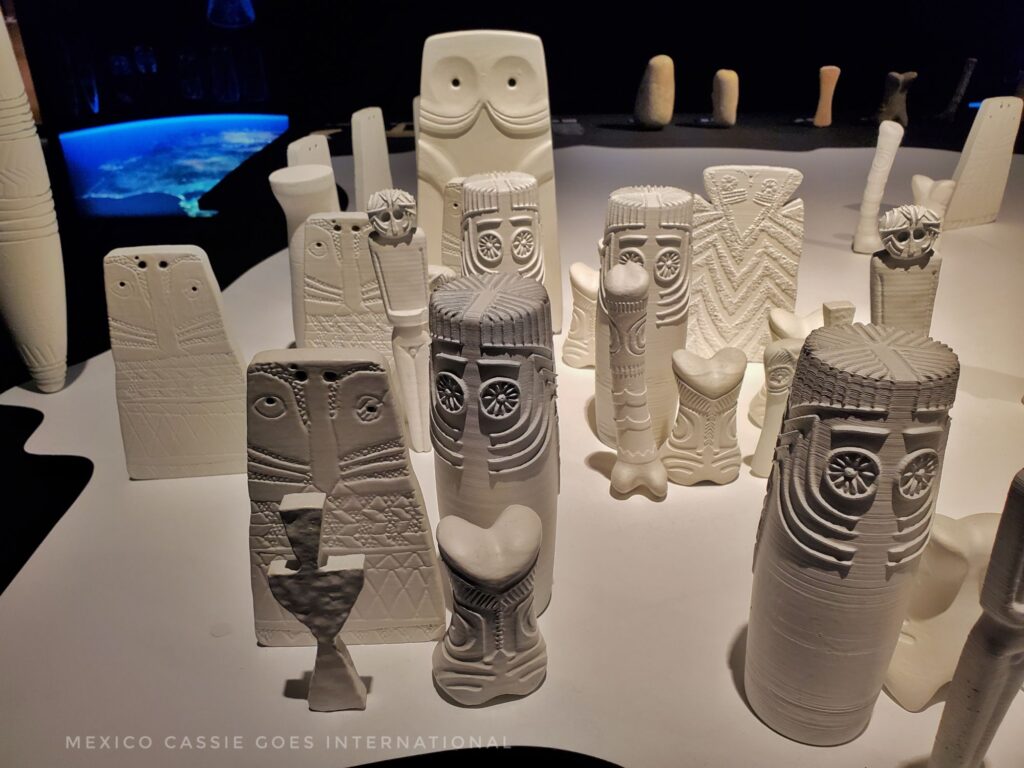
The Huelva City museum is an absolute gem of a museum, not only is it free but it’s packed full of fascinating artefacts and exhibitions including the only Roman wooden water wheel remaining in the world.
Note that there are no English explanations but it’s so good that I recommend using Google Translate and going anyway.
Muelle de Riotinto
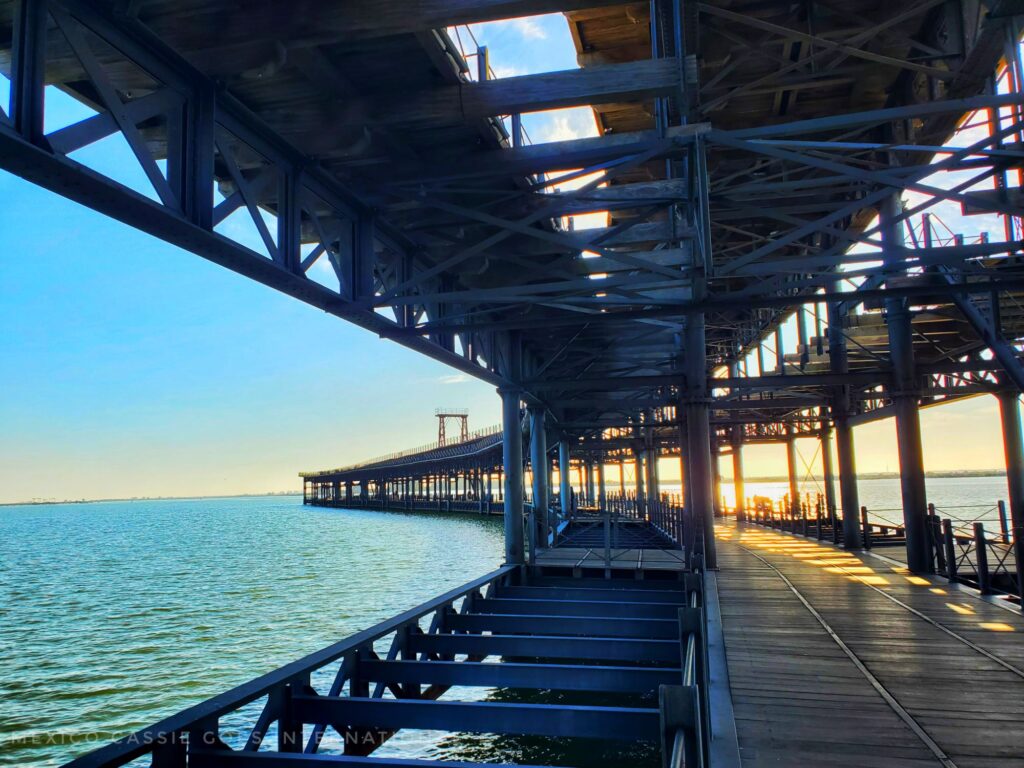
The muelle de Riotinto is a restored 19th century pier that is open for pedestrians and it’s one of my favourite spots for a bit of ‘R and R’.
The pier was used by ships until 1975 when they transferred to the modern docks just down the road (visible from the muelle). Although not a long walk (just over 1km), it is a true delight to stroll along the restored pier marvelling at the River Odiel sparkling under the Andalucian sun.
Both Parque Zafra and the Paseo de la Ría are great options for a further walk, if you’re looking for somewhere to relax.
Focus on Christoper Columbus
Cristóbal Colón, as he is called in Spain, was actually Italian but it was with the financial backing of Ferdinand and Isabella of Spain that he set out to stumble onto the Americas (by the way, if you want to say he discovered the Americas, please use air quotes or qualify or more accurately say he discovered the Americas FOR the Europeans. Whole civilizations already knew where they were).
There are three particularly important locations in the province of Huelva in relation to Colón: La Rábida, Palos de la Frontera and Moguer. All lie along the bank of the Río Tinto estuary.
Other Sites in Huelva
Casa Colón (Columbus House) – a historical landmark that used to be a hotel. Today events are held here.
Statue of Cristopher Columbus – it’s a statue on Plaza de la Monjas
Santa Iglesia Catedral de la Merced – a cathedral built in the 18th century
Where to Eat in Huelva City
Whatever your plans, I recommend booking in advance as when we showed up on a regular Saturday in January and couldn’t get a table at the restaurants we’d researched. As it was, we discovered somewhere incredible thanks to our lack of booking but we were also lucky to get a table.
Muxo Smash Burger ⭐️ ⭐️ ⭐️ ⭐️ ⭐️
A new (in 2023) upmarket burger joint in Huelva. All 5 of us declared our burgers to be the best we’ve ever had and the staff were incredibly kind and welcoming too.
Restaurante Masero
We couldn’t get a table here but the reviews for this traditional tapas restaurant are fabulous.
🧭 Av Martín Alonson Pinzón and Calle Vazquez Lopez were both full of restaurants with very happy looking customers dining both inside and outside.
If you’re interested in staying longer in Huelva City there are a few hotels to choose from.
La Rábida
Here, on the banks of the Río Tinto estuary is La Rábida Monastery where Columbus lived for a year while waiting for his dosh from the Spanish crown.
What to do in La Rábida
Visit the monastery
The monks offer a tour in Spanish – I haven’t taken it but I’m sure it’s interesting.
Muelle de las Carabelas
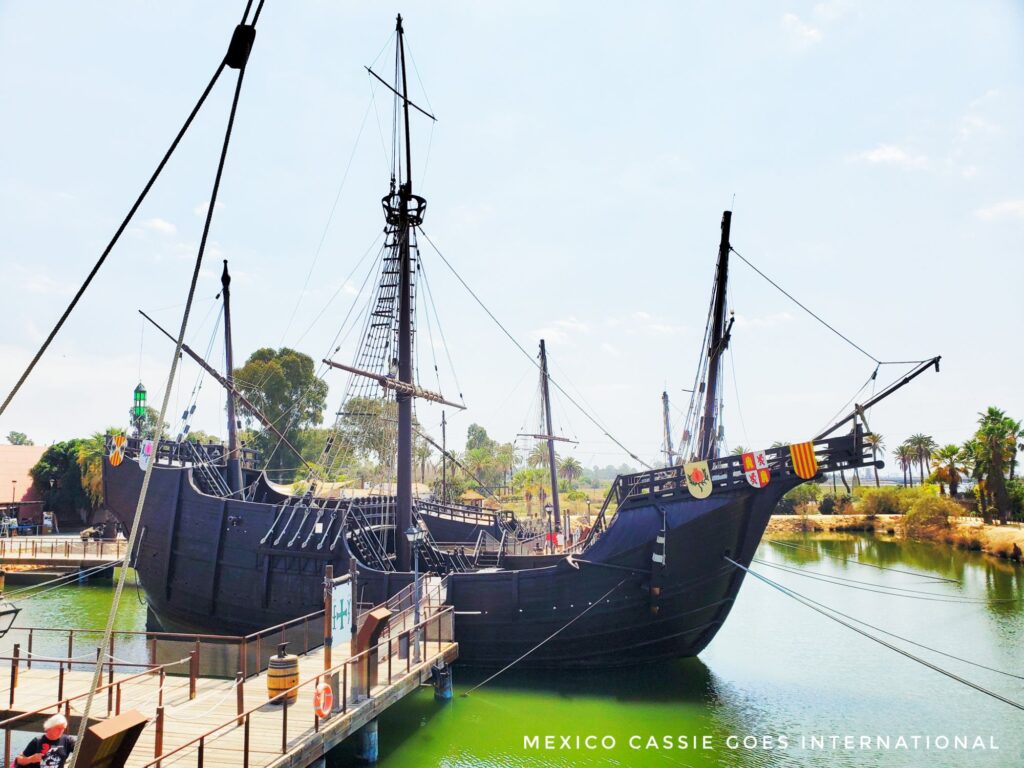
On the Muelle de las Carabelas (Harbour of the Caravels) is a small museum next to a quay with full-size replicas of the ships in which Columbus sailed to the Americas. The ships are fun to explore as is the museum although if you know anything about colonialism, please know that your hackles may rise once or twice.
The ships, by the way, are the Santa Maria, La Pinta and La Niña.
Parque Botanico José Celestino Mutis
This is a beautiful botanical gardens over 30 acres that houses plants from all over the world.
Paseo de los Escudos (Path of the shields)

This path runs alongside the park up to the Monumento a los Descubridores (sigh). The park is a joyous place where local families picnic and frolic. The path of shields is fun as you can try and work out to which countries the shields belong. Also look out for the Aztec Calendar here.
Palos de la Frontera
Just a ten minute drive from La Rábida, is Palos de la Frontera. Its claim to fame is that people view it as the birthplace of the “discovery of America”. It is from here, in 1492, that Cristopher Columbus and his crew set sail to change the course of history.
Visit the Casa Museo de los Pinzón (the brothers who went with Columbus), the Iglesia de San Jorge and the Fontanilla are the main sites in Palos de la Frontera.
Moguer
This small town is part of the Columbus story because his ship, La Niña, was built here.
Niebla
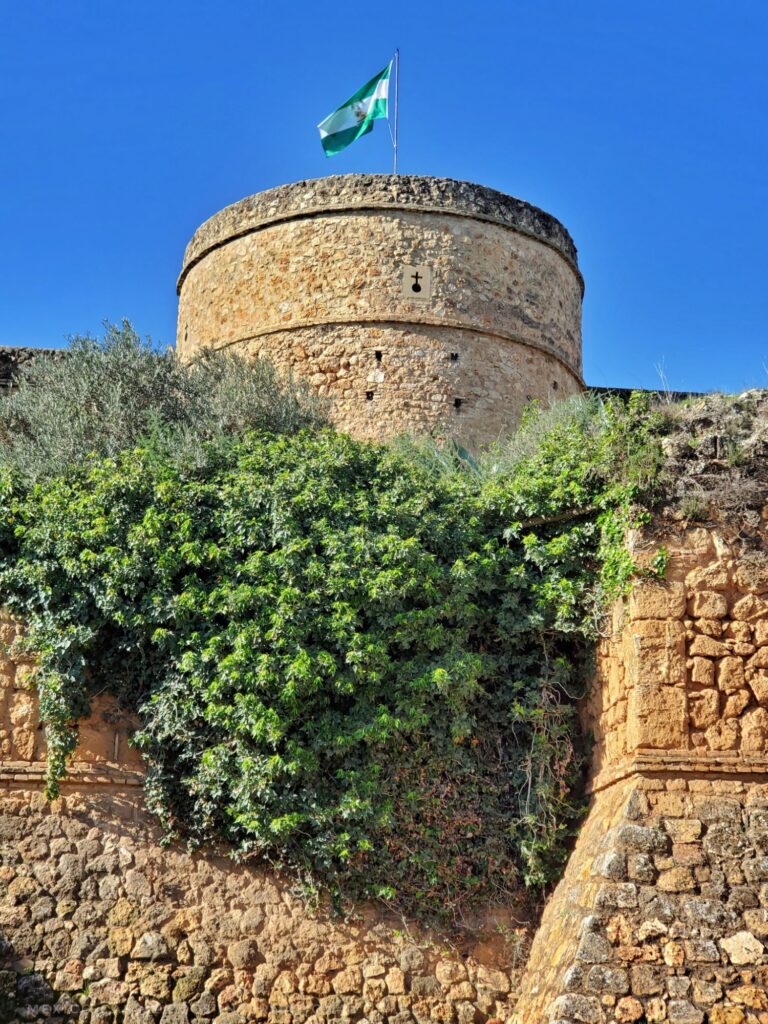
📍 Just 30 km from Huelva and 60 km from Sevilla, Niebla makes a great day trip from either city. We spent a lovely birthday treat day here recently.
➡️ Niebla is at least 3,000 years old and it was important due to the silver industry, which was exploited by the Phoenician traders as well as the Romans. The Romans called Niebla ‘Ilipla’. This small town was once a great city so it’s odd that it’s been forgotten by most in our modern age.
Even today, Niebla is surrounded by an impressive city wall that touches a 15th century Alcazar. The city is accessed by remaining ancient gates: Puerta del Agua (Water), Puerta del Buey (Ox), Puerta del Socorro (Relief), Puerta del Agujero (Hole), and the Puerta de Sevilla
Just outside the city walls is a fully functioning Roman Bridge that is still in use today.
What to do in Niebla
Visit the Castillo de Niebla o de los Guzmanes
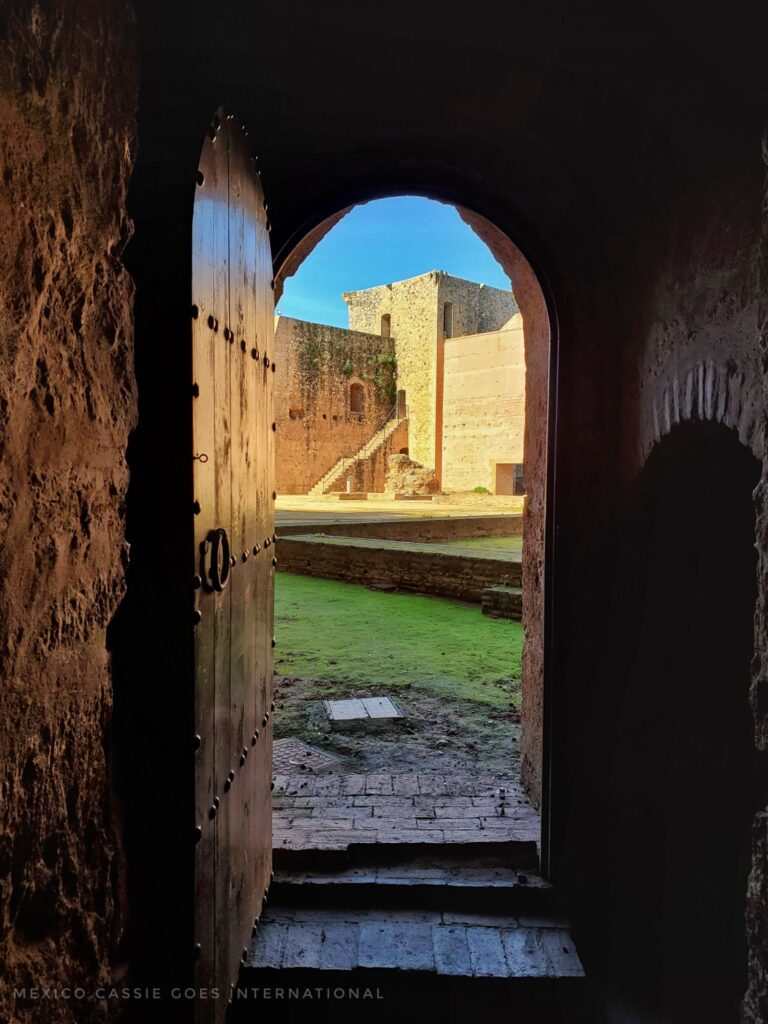
This large medieval castle was built to protect the image of the Guzmanes in the region. It was built on the site of an earlier alcazar. There are some good interactive displays within the museum and it’s fun to walk around the walls.
Follow the city walls
Follow the walls and then grab a drink from one of the many road side cafes that run along the walls.
Walk alongside the Rio Tinto
Cross over the Roman Bridge and head down to the Rio Tinto to gaze at the weirdly red river (just don’t touch). If you’re there during stork season you’ll see plenty of their giant nests on pylons along the river.
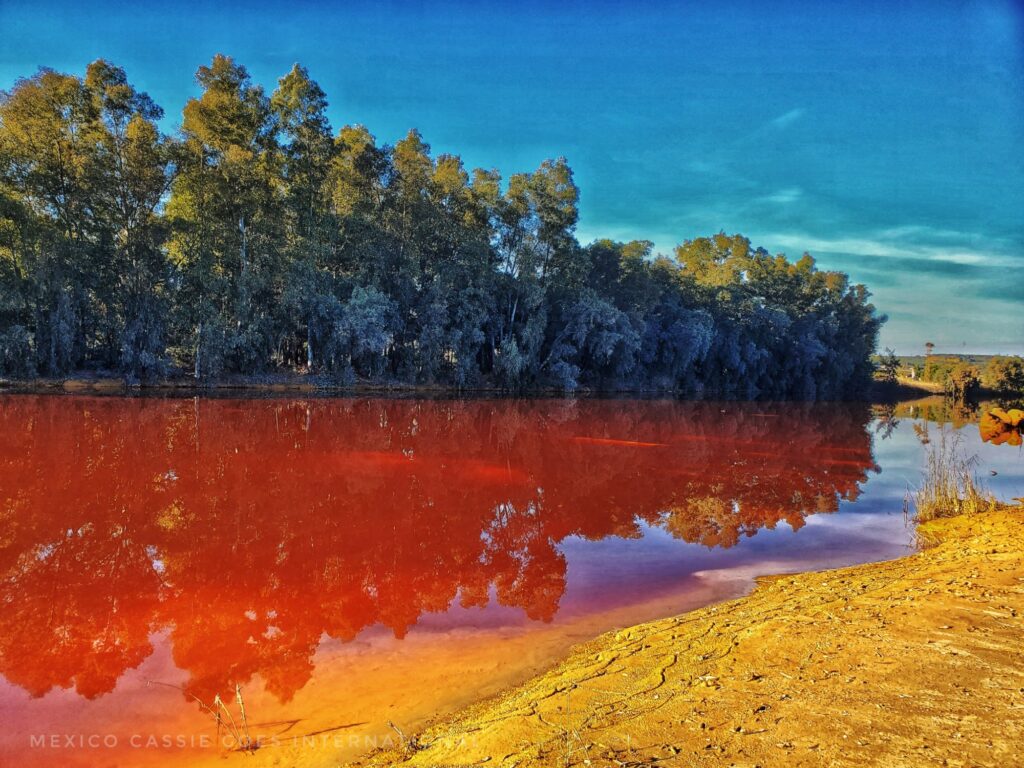
Iglesia San Martín
Check out the open air nave. Apparently when the nave’s roof was in danger of collapsing they just removed it, leaving this gorgeous space that will leave you quietly pondering the whys, and wherefores of life.
Focus on: why is the Rio Tinto red?
Rio Tinto, of course, means Red River – using not the regular word for red, rojo, but the boozy word for red – tinto. It is around Niebla where the river starts to lose the red as it blends with other waters but don’t worry, it’s still red-red.
This area has been the site of ore mining for around 5,000 years (for copper, silver and gold). Acid mine drainage over so many thousands of years has led to the high levels of acid in the water. The reason the Rio Tinto is so red is because this acid runoff that makes the river inhospitable for most life has made it more welcoming to sulfide-consuming bacteria that give the river its red tint by producing ferric iron.
Basically, it looks fabulous but it’s really not a great thing that the water is so polluted even if it is a super historical pollution.
Oh yeah, and don’t fall in it. One of my kids put her hands in it before we could stop her. We’re still on the lookout for super powers.
El Rocío

Whatever you’re expecting from El Rocío, it probably won’t be what you get. I had declared that I had zero interest in visiting this strange small town that I had vaguely heard of as being super religious. A Spanish friend sensibly told me to shut up and insisted we visit. I’m glad she did because it’s an interesting place for sure.
Yes, it’s a town for pilgrims who meet here every Whitsunday (May/June generally, after Holy Week, I believe) following their pilgrimage, La Romería de El Rocío – Spain’s largest religious festival.
Focus on La Romería de El Rocío
Nearly one million people from across Spain make this pilgrimage every year. While the pilgrimage begins on the Sunday before Whitsunday (Pentecost), people coming from the region will often travel for days to reach their starting point, either on foot, horseback, in wagons or even ATVs. Most sleep outside and this is considered an important part of their pilgrimage.
They’re coming to town to see an image of Nuestra Señora del Rocío that was found in a tree by a hunter from Almonte in the 13th century. A chapel was built on the site of the tree and the rest is… history.
The pilgrims are hardly the sober image you probably have in mind. They basically party their way to El Rocío doing all the things that you do when you drink too much – they sing, they dance, they laugh and they, yeah, you get the picture. This carries on in El Rocío when everyone wants a turn with the virgin (weird sentence to write). She gets to visit each hermandad and is then returned to the church.
What to do in El Rocío
Walk around the sandy streets
There are no paved roads in El Rocío, instead, the roads are sand.
Marvel at the weird ghost town feel
Know, though that the apparently empty buildings are the property of 115 hermandades (brotherhoods) where the pilgrims stay and party when they reach town.
Ermita del Rocío
This impressive white church is sadly not as old as you’d hope it to be, having been built in 1964. However, this doesn’t mean it isn’t extremely impressive to see. Devotees of the Virgen del Rocio show up daily to see the idol (it’s a small wooden image of Mary dressed in long robes that’s kept above the altar)
Take a stroll around the Charco de la Boca
Walk towards the Francisco Bernis Birdwatching Centre. El Rocío is on the edge of the Doñana National Park and the marshlands here are awesome for bird watching.
Aracena
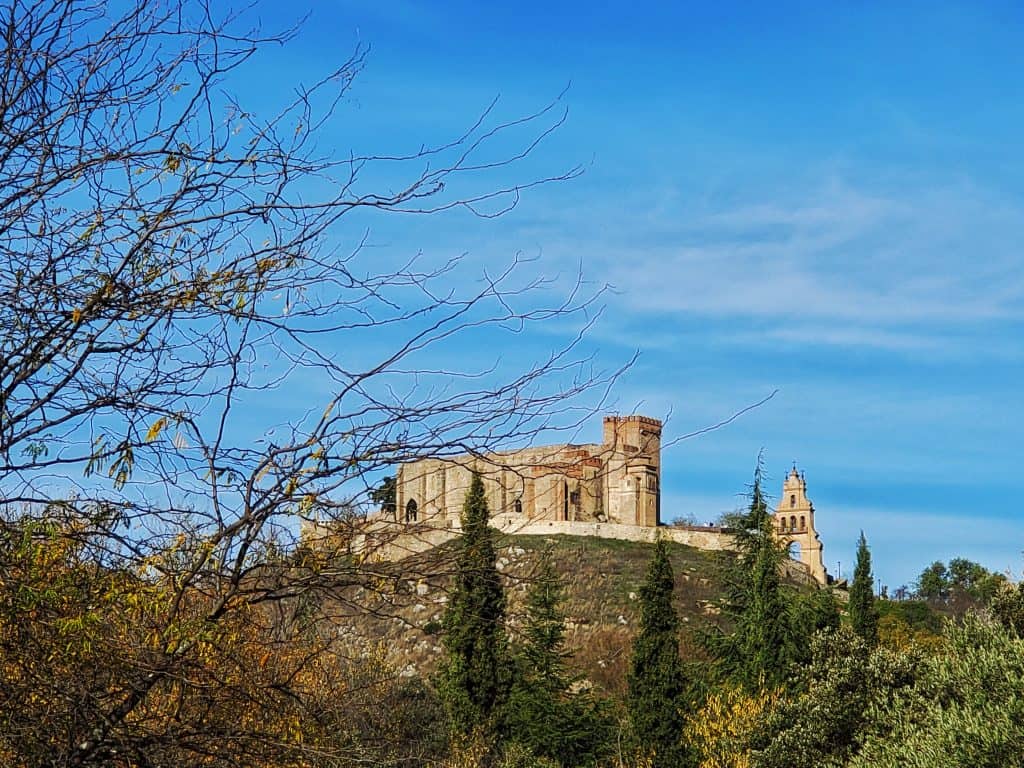
📍 Aracena is a gorgeous small town nestled in the Sierra de Aracena mountain range just a few hours drive from Seville. It is the perfect location for a European weekend city-break or a short stay if you’re busy exploring Andalucia.
Aracena, like so much of Huelva, barely registers on the foreign tourist trails of Spain despite having been named a “Tourist Municipality of Andalucía” in 2006, the first town in Huelva to receive this recognition.
What to do in Aracena
Visit the Gruta de las Maravillas
This incredible cave system contains fabulous underground lakes, weird rock formations, stalactites, stalagmites and columns.
Plaza de San Pedro /Plaza de la Gruta de Maravillas
Upon exiting the cave complex you’ll find yourself in a touristy area with shops and restaurants. Check out the Outdoor Museum of Contemporary Andalusian Art and the Lavadero Fuente De Concejo where locals used to congregate to wash their clothes is also right here and is worth a moment of your time.
Castle and Priory Church
Up on the hill dominating your every thought as you explore the gorgeous town that is Aracena, this combo can’t be missed. Together the two are known as Castillo-Iglesia de Nuestra Señora de los Dolores. The easiest way up is via the stunning Plaza Alta (the plaza that used to be the centre of town). Here, you’ll find signs pointing out the narrow path up the hill.
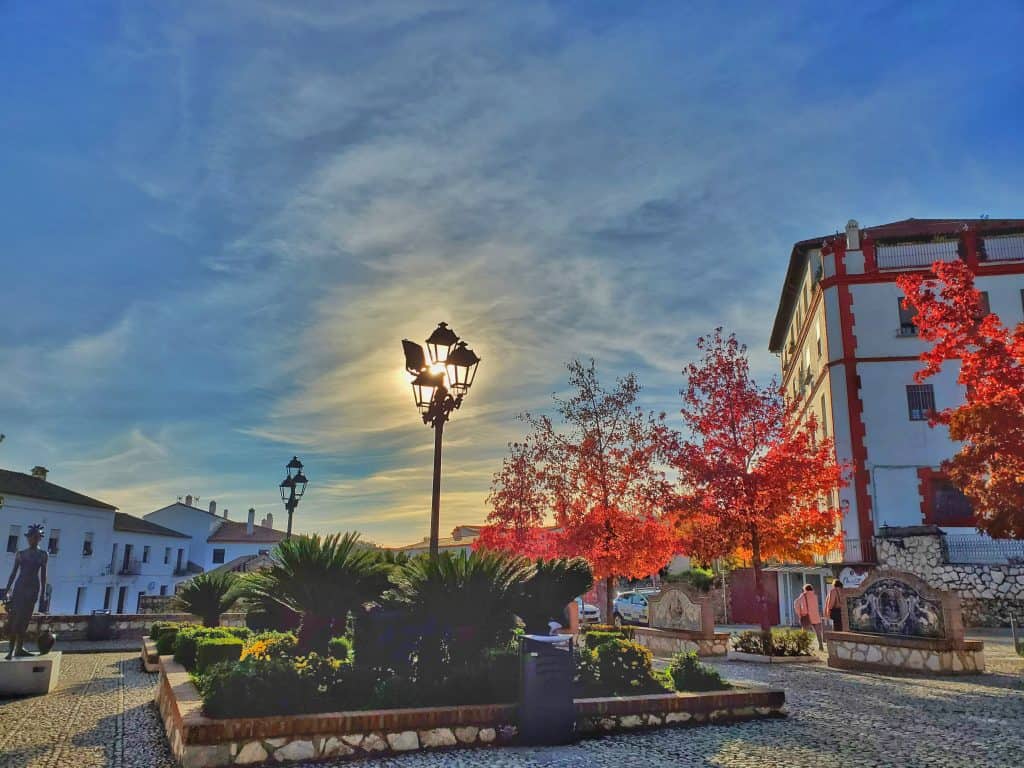
Explore old town
Wander the winding, steep streets, grab a snack in the delicatessens, or an excellent meal in any one of the fabulous restaurants in town. If you’re in Aracena in winter, be sure to focus on mushrooms as this is one of the foremost mushroom regions of Andalucia.
Museo del Jamon
This small museum is worth sticking your head inside although don’t expect it to take long.
When I’m asked about Aracena, I tell people that it’s one of the top places to visit in all of Andalucia, not just in Huelva.
⭐️ Take a tour to Aracena and the Río Tinto Mines from Sevilla
➡️ Read more about visiting Aracena.
Almonaster La Real
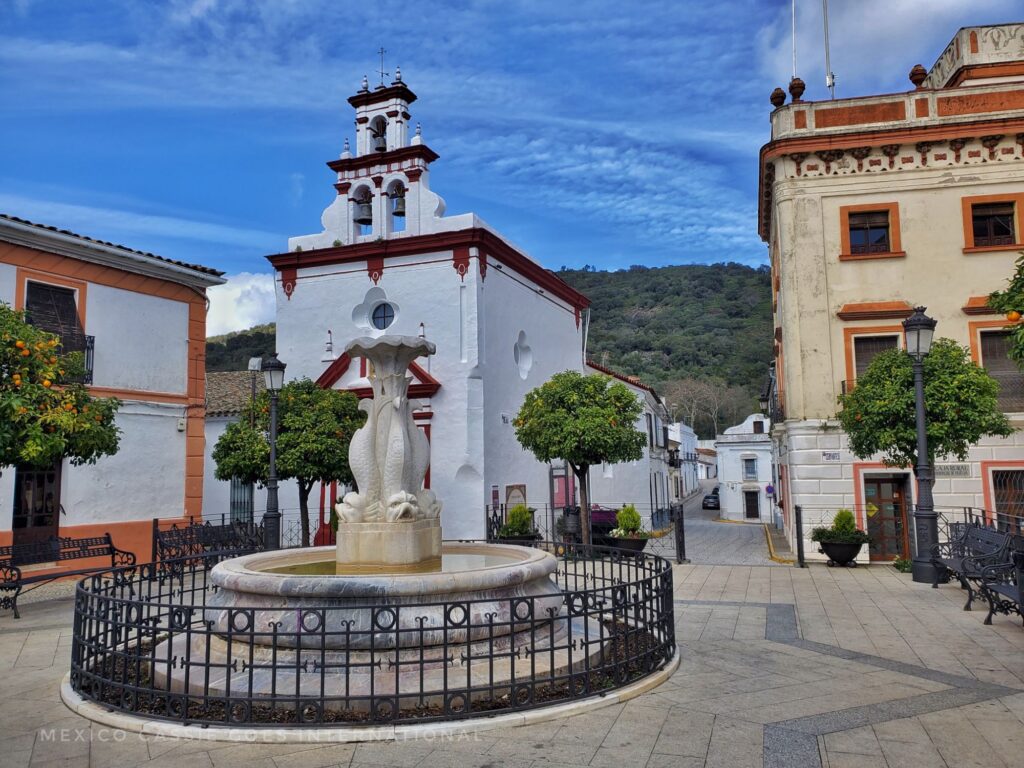
This gorgeous and tiny town in the north of Huelva Province sits on the edge of the Sierra de Aracena and the Picos de Aroche Natural Park. People visit for the architecture, cobbled streets and long history.
🚗 It’s a perfect place to visit for the day from a bigger city such as Aracena (30 mins), Sevilla (2 hr) or Huelva (1hr25), or if you really enjoy peaceful quiet places, to stay a few nights.
What to do in Almonaster
Visit the Mezquita
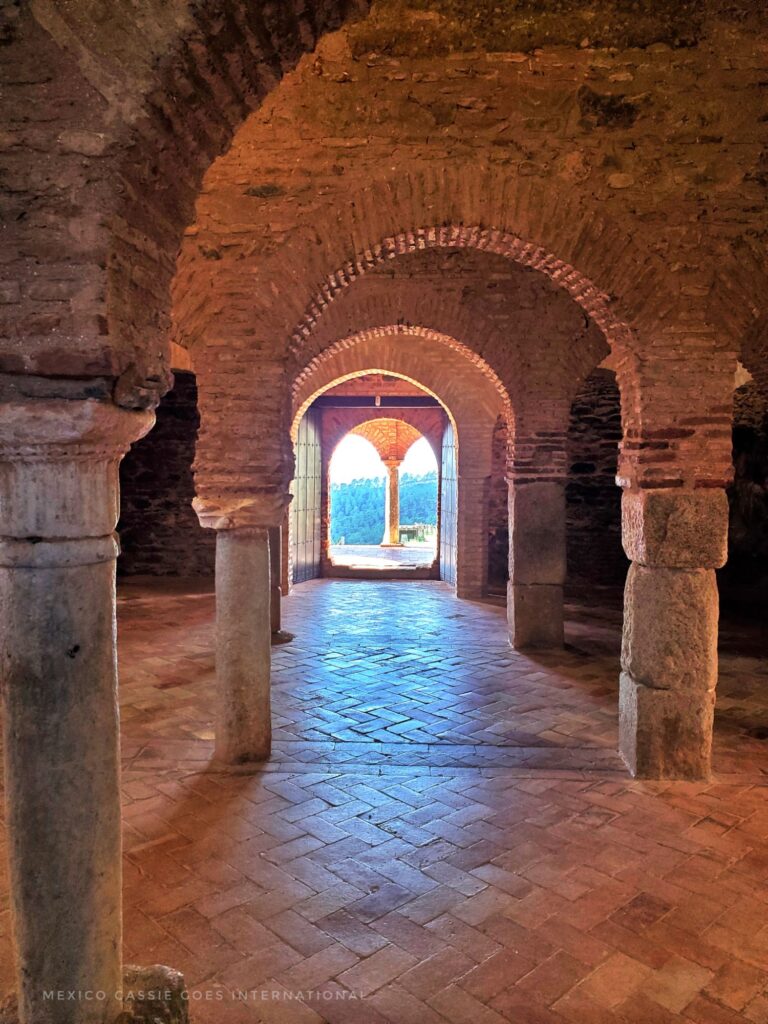
Up on the hill overlooking the pueblo is the the tenth century mosque (mezquita). This is one of the few surviving rural mosques in Spain and it’s really an extremely special place to see. Not only is it at tenth century building but its architects also incorporated Visigoth and Roman structural sections into the design.
Focus on the Visiting the Mezquita
As soon as you arrive in Almonaster la Real you can see the mezquita. There is a gentle pedestrian pathway that winds around the hill to reach the entrance as well as a steeper road (although be clear, there is no vehicular entry permitted for non-residents).
If you’ve ever visited the mezquita in Córdoba, you’ll immediately recognise the architectural style here. If you haven’t yet visited Córdoba then this is a fabulous alternative to the much more famous mezquita there. It’s low-key, unrestored and empty but the past is palpable in a way it simply can’t be when you’re sharing the moment with hundreds of other people.
I was absolutely overwhelmed by the history and the beauty of the building when I walked inside. There was no one else there, just me and a thousand years of history, all alone.
Visit the Plaza de Toros
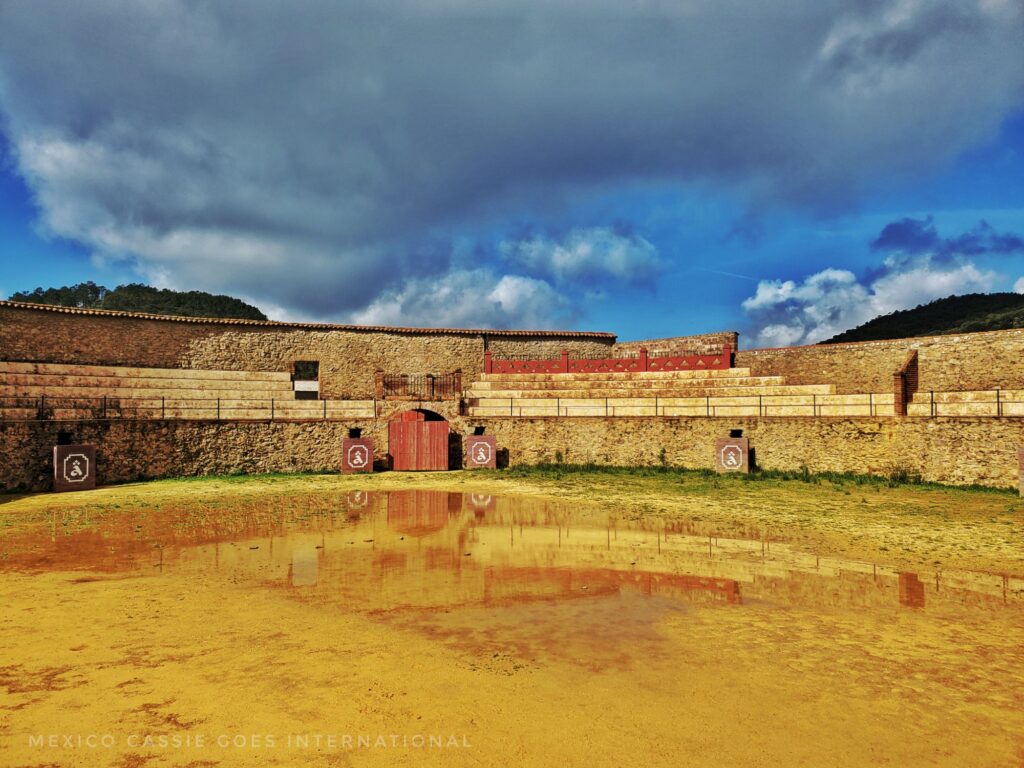
Right next door to the mezquita is an old bull ring. If the door is open, stick your head in because it’s there. It isn’t active, don’t worry.
Walk around the town
See the plazas, the concejo (communal wash house), enjoy the cobbled streets and the total lack of people! There are a few restaurants in town and all get excellent reviews. We chose one at random (el Mesón Miguel Tenorio) and it was fabulous.
Expocisión El Buscador de Setas
As you walk up the hill to the mezquita you’ll pass a row of lovingly restored stables, a few of which now house a small local museum dedicated to the human history of the area. It’s well worth spending 20 minutes here especially if the owner is around as he’s a fascinating guy.
Visit the miradors (viewpoints)
🚗 Note on parking: there is free parking just outside town (it’s a small town). I don’t recommend trying to drive through Almonaster la Real – I did it, I regret it.
Pueblos Magicos in Huelva
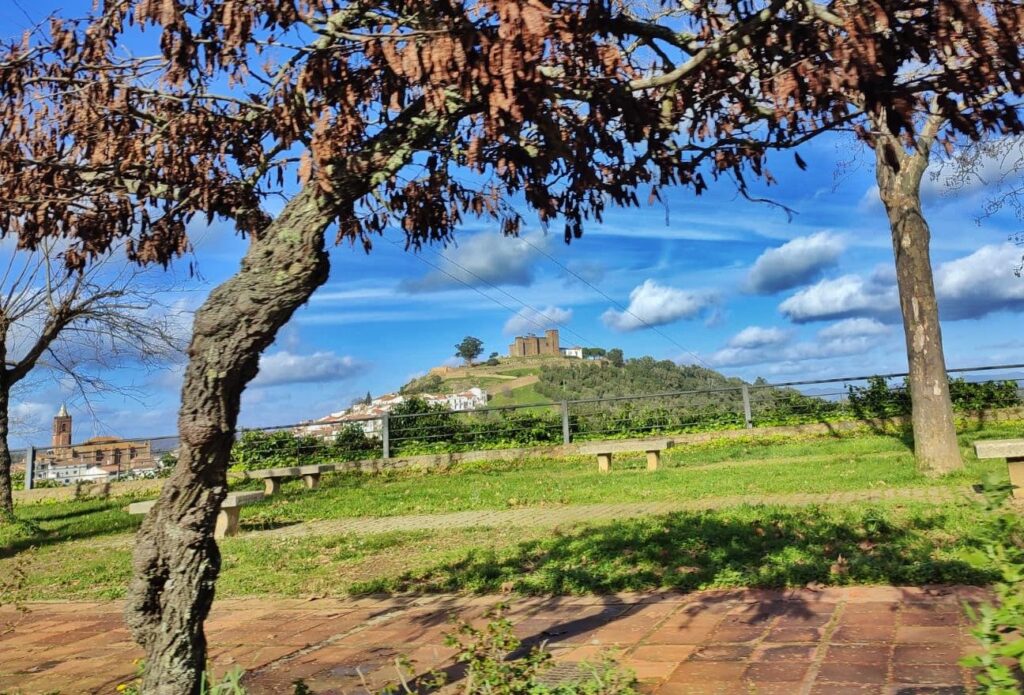
⭐️ There are 5 pueblos magicos in Huelva: Puerto Moral, Higuera de la Sierra, Cortegana, Cumbres Mayores and Palos de la Frontera.
Except for Palos de la Frontera, all are located in northern Huelva. They could be visited as a fun and easy day trip from Seville or as part of a road trip around the province. None are large places that will take up much of your time.
Could I take a Huelva road trip?
Absolutely, I think a road trip around Huelva would be a fabulous idea, particularly for those who feel they have seen the major sites in Andalucía and are looking for something new or different. This would be a peaceful trip, getting to see the gorgeous rolling hills of northern Huelva and the incredible wetlands and beaches in southern Huelva.
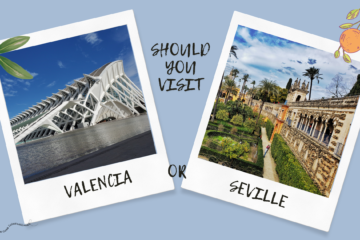
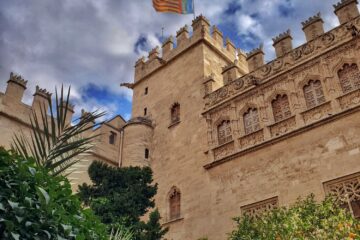
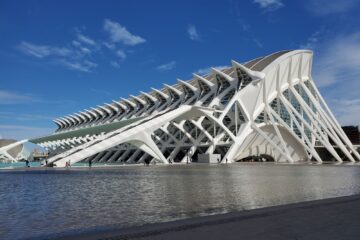
0 Comments